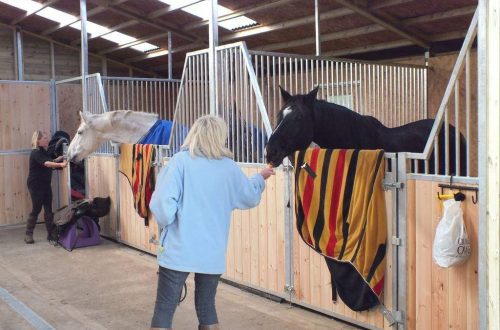
Driving work: theory and practice
Driving work: theory and practice
Why do you need work on the reins?
Riding is an excellent training technique to support work under the saddle, useful for both the horse and its trainer. I have repeatedly noticed that horses love this type of work, because, on the one hand, it is easier for them (they do not have to carry the weight of the rider), and, on the other hand, such work creates a closer connection between man and animal, as they literally work “side by side”, and a person has to expend no less energy than a horse.
The rider, training a horse in this way, can learn a lot about the technical, biomechanical aspects of his training, because, working on the reins, he sees his whole body, and especially his legs. By being able to observe exactly where and at what moment each leg is and what it is doing, he can gain a sense of the right timing, which will help in work under the saddle. Since the person is not sitting on the horse, he can focus on the reins without worrying about the seat.
Rein work is also an excellent diagnostic tool, as chains of cause and effect become apparent to the rider. If in work under saddle a problem arises, the cause of which cannot be found, it can be identified with a sufficiently high degree of probability by working on the reins. Faults will not be masked by the participation of the weight and legs of the rider.
Horse starts better work under the saddle, because, working on the reins, it is easier for her to explain some things. The rider improves his sense of the horse. Moving behind her and holding the reins, he gets a visual impression of the functioning of the back and hindquarters, flexion and balance. At the same time, he feels the whole body of the horse in his hands. Later, this visual impression can be correlated with the feelings that the rider experiences in the saddle. Thus, both types of work complement each other, allowing you to get a positive effect.
Potential Disadvantages
Of course, working on the reins has its drawbacks and limitations. For example, it is difficult to develop a good lateral bend due to the lack of controls – weight and legs. Many horses tend to push their hindquarters up and canter “downhill”, which is not easily corrected on the reins for the same reasons. Therefore, training on the reins should be combined with regular riding work. At the Spanish Riding School in Vienna, the horses that ride the reins work four days a week under the saddle and only two on the reins.
The biggest danger in work on the reins is that the horse begins to slow down. To avoid this, you need to regularly move the horse forward under the saddle, on a lunge or on a double lunge. Lengthening the pace of the trot on the reins, transitions between trot and canter can also help. Horses that have already learned to piaffe in the hands can take a few piaffe steps with the trainer at the shoulder, this will restore the activity of the hindquarters, and also encourage the horse to move “uphill”.
Differences of work on the reins (Long Reining) from work on two cords and Ground Driving
Riding is traditionally considered a form of riding rather than driving, which is often mistaken for. Therefore, we say, for example: we are going to turn or move on a long rein (Long Rein). At its core, this is a type of collected work that is practiced predominantly in the collected trot or canter, so it is not very suitable for young horses (unlike Ground Driving).
Driving and Ground Driving are performed using driving reins. The driver maintains a relatively large distance to the horse, and in doing so, in contrast to the work on the reins, the young horse works a lot on the walk. The horse is put on driving gear, including a bridle. Work is generally limited to straight lines and simple turns. When working on the reins, the trainer is close enough to the horse to touch it, while the horse is wearing a riding bridle. The reins are shorter than the driving reins. The horse is taught all dressage movements, including lateral movements, change of foot, pirouettes, piaffes and half passes.
This type of training is also different from two-line work, during which the horse is put on a lead and the lines are passed through the rings on its sides. When working on two lunges, the trainer usually stands in the center of the circle and the horse moves around it. The circle can be moved up and down the long side of the arena. The horse works mainly at the trot and canter, but the degree of collection is generally lower than when working on the reins. But you can easily turn double lunge work into rein work by closing the distance between you and the horse and standing behind him. This is why double lunging is a very good preparation and introduction to rein work.
Timing and horse
Because bоMost of the work on the reins takes place in collected trot and canter and should not be started too early (before the second level of training). Horses that are not yet able to gather sufficiently move faster, and their trainer has to move faster, too. With smaller horses this is a little easier, especially if the rider is tall. But if the horse is large, the task becomes more complicated at times.
Not every rider has the necessary level of “fitness” for rein work, leg length or stride length. The horse’s ability to collect dictates how much you can move him forward (under the saddle as well as on the reins) so that he doesn’t fall behind and over the controls (this creates muscle blockages and causes other problems). If the rider is not able to keep up with the horse at minimum speed, he will inevitably be held by the reins, which can cause a lot of serious problems in a short period of time. In such cases, work on the reins must be suspended.
When choosing a horse for this kind of training, its good will should be a priority. Avoid horses that are kicking. The horse needs to respond adequately to what is happening behind him – this way you will reduce the risk of injury if something goes wrong.
The horse for work on the reins should not be too high. When a horse is very tall, the rider actually has to run after it to keep up, or the horse will have to work in a very high collection. In classic rein work, the rider walks behind the horse while the horse trots or gallops. The walking trainer is more stable. If he runs, then there is a suspension phase during which it is difficult to perform a half-halt. Working with young or tall horses, as well as participating in the training of a short rider, is considered an exception to the rule.
Rider position
Speaking about the position of the rider in relation to the horse, several relevant traditions can be distinguished. At Egon von Neindorff’s Riding Institute, the rider usually walks in the middle behind the horse. At the Spanish Riding School in Vienna, the rider walks beside the inside hind leg in walk and trot, next to the outside hind leg during the halfway and canter, and in the middle behind the horse during the piaffe, passage and changes in tempo. I myself try to be in a place where I can influence the horse with maximum efficiency. Practice shows that it is especially effective to walk next to the horse’s non-supporting back leg, because this way you can better control it with your body, preventing it from moving to the side. However, in order to be able to communicate optimally with the horse, one has to change positions frequently.
Equipment
In terms of equipment, the classical tradition uses a regular snaffle or barbed snaffle with a Hanoverian noseband, 5-6 m (15-18 ft) long reins, depending on the size of the horse, and a whip. At the very beginning of the training, you can also use the lunge – it will allow you to stay at a great distance from the horse.
Currently, you can see trainers working on the reins with a mouthpiece. But in fact, this happens to hide problems with contact. I am convinced that it would be more effective (and more honest) to first develop the neck and ganache area of the horse through special gymnastic exercises, so that the horse can go hand in hand on a simple snaffle.
I believe that using the edge or side reins while working on the reins is more harmful than helpful. I am also against the use of leverage – it is easy to create such a powerful pressure in the horse’s mouth that he will “twist” his neck and go behind the reins, which is almost impossible to fix on the reins.
Management tools
The principles of this type of horse training are consistent with the principles of training under the saddle, on the lunge and in the hands.
Unlike under saddle work, the rider does not have the ability to use weight and legs – only voice, whip and reins. Alternatively, you can touch the horse’s thigh with the back of your hand or forearm to ask him to take a side step; you can push the hind leg with your hand from behind to encourage the horse to move forward, and you can also push the croup from above with your hand or reins during the half-halt to ask for a deeper bend in the hind legs.
When working on the reins, your physical form will matter. The fact is that the controls must be fixed and coordinated by the muscles of the core. A common beginner’s mistake is to walk like a “duck”, leaning forward and sticking out the buttocks. In this posture it is impossible to send the horse forward from the hindquarters to contact the reins with the muscles of the core. The horse begins to walk “separately”, the rear is separate from the front. Thus, the rider’s pelvis must be vertical under the shoulders, and the back muscles must be well connected to create rear-to-front pressure that will push the horse onto the reins.
The whip can be held vertically up to touch the croup from above, or vertically down to touch the hind leg from the back or side. Holding the whip horizontal, you can reach into the girth area to encourage the horse to move forward or sideways. The whip should not be too long if you are walking close to the horse. The greater the distance between horse and rider, the longer the whip can be.
Brief information about the training
In the early stages of lunging, a lot of time is spent walking and trotting on the first lane along the arena, which is often not an easy task, especially on the horse’s stiffer side – he can slide over the inside shoulder into the middle of the arena away from the wall. You need to practice many transitions between walk, trot and halt. The corners must be traversed from the reinforcement of the internal controls. This is done most effectively by following the horse’s outside hind leg in the corner and pulling the horse into the corner with the inside rein, reinforcing your hold if necessary. whip.
Working on the reins in a circle allows the rider to straighten the horse and improve the lateral elasticity of his spine by connecting the inside hind leg to the outside front leg. This can be done, for example, by stepping behind the outside hind leg and pushing the inside hind leg forward and out towards the outside shoulder. This can easily be turned into shoulder-in along the long side of the arena by riding wide, driving the outside rein through the middle of the croup, and engaging the inside hind leg with the inside rein. The whip can either drive the outside hind leg forward or ask the inside hind leg to cross the outside.
When working on curved lines, many horses sooner or later begin to offer a canter. In these cases it is extremely important that the rider immediately move forward with the horse in order to maintain the canter so that the horse never gets the impression that the canter is not desirable. If the rider suppresses the canter or punishes the horse for it, he will easily discourage his desire to canter. In such situations, we must pay attention to what prompted the horse to gallop. We can then try to repeat these controls to get the horse into a canter later on.
At the beginning of the work on the reins, working at a canter, you will need to move the horse forward. It is important at this stage that the horse learns to canter on both legs without breaking into a trot. Eventually the rider picks up the canter by holding the horse’s shoulders a little longer at the highest point through a half halt. Sometimes, when the horse’s hind legs are carried forward, you need to support him so that he does not stray into a trot.
I personally start engaging the canter as soon as the horse offers it for the first time. Some horses do this in the first few sessions, others only after a few weeks or months of trotting.
If the horse is doing well at the canter, you can include short canter reprises to practice restraint. I also recommend following the traditional training sequence angle -> volt -> shoulder in -> hip in -> half.
The hip-in is the easiest lateral movement a horse can be taught, but the hardest thing is to turn it off again. Many horses do it with such enthusiasm that it is easy to lose control of the inside hind leg. Thus, the rider must be ready to catch and trim the inside hip with the inside rein while working the inside hip. This is why the transitions between shoulder-in and hip-in are particularly useful. This way you won’t let any of the hind legs fall out to the side.
As you work on the hauls, keep in mind that it is easiest to perform them by turning into the center line and moving from the middle of the short wall to the middle of the long wall, because turning to the center line is easier initially than leading the horse from the long wall to the diagonal. As with the under saddle half pass, it is important that you first diagonalize the shoulders and then ask the horse to take a side step backwards. Otherwise, the hindquarters will be ahead of the front and the horse will go hips, his body will twist and he will be out of control of the controls. The inside hind leg should be well under the center of gravity and move from the back to the front, and the shoulders should move ahead of the inside hind leg.
Once the horse has learned to perform simple lateral movements with relative ease, advanced elements can be incorporated into the work, such as counter-changes of bending, zig-zag half-halfs, changes in pace, and pirouettes.
At the same time, you can start training the horse to do the piaffe in the hands.
Dr. Thomas Ritter (source); translation by Valeria Smirnova.





